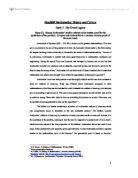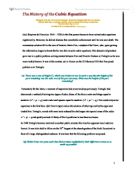Newton firmly established the idea of differentiation and integration being inverse operations of each other. He did this by considering the moving ordinate (y coordinate) as proportional to the fluxion of an area. Newton used the standard dot notation to represent differentiation but did not introduce any specialised notation for integration. This was possibly because, as he worked alone for a period of time during the great plague, he felt it unnecessary as he could achieve most of what he wanted without too much in the way of suggestive symbolism. But because he did not discuss his notation, or lack of it, with other mathematicians this maybe a reason for the problems he had with the publishing of his work. Notation may not have important to Newton but is certainly is to those who followed him after.1
Newton was constantly seeking to establish his analytical methods on a more secure foundation. Since Newton was mainly working in the context of “discovery methods” he was unable to rigorously justify these methods themselves. This would cause controversy for more than a century after his death.
In the century of Kepler, Galileo, Descartes, Pascal and of course Newton, the most versatile genius of all was Gottfried Wilhelm Leibniz (1646 - 1716). He visited Paris in 1672 and his stay there for 4 great years was to be momentous for his mathematical and scientific career, for as well as making contacts, he formulated his version of calculus there.
In infinitesimal mathematics he favoured the rigorous Archimedean style as the most trustworthy, but he knew and applied the new infinitesimal methods of the 17th century as well.1
Leibniz studied difference sequences in his early Paris years and after being posed several problems by Huygens he acquired an insight. This he used and applied to the summation of a number of different series. He noticed that the problem of quadrature can be considered as a kind of summation of a sequence of equidistant ordinates. Leibniz found that as the distance between ordinates became smaller the approximation of the quadrature became better. He then imagined that if this distance was made infinitely small then the approximation would become exact. So Leibniz saw an analogy between the calculus of finite differences and sums, the summation of sequences would correspond to the quadrature of curves. But he needed symbols that would guarantee the correctness of his argument and to translate his mathematical statements into formulas and algorithms.3
This led Leibniz to the philosophical principle of the idea of characteristica generalis, a general symbolic language into which all processes of reasoning and argument could be translated, a tool that influenced Leibniz’s discovery and invention of the calculus.3 So Leibniz introduced new symbols to be thought of not as variables but as standing for operations.6 He used the symbols we use today, ∫ for integration meaning summa, the sum, and the symbol d to denote differentiation and the inverse of ∫. The choice of ∫ shows the analogy Leibniz made between the calculus of sums and differences and the calculus of quadratures. Leibniz used these symbols to formulate rules and write down relations like ∫ydy = y2/2. Later he came to write ∫ydx for the area under the curve y(x), considering it as a sum of rectangles with area y∙dx.1
Newton and Leibniz each created a coherent system of methods that could be used to solve problems. The coherence of their systems was gained by recognition of the fundamental theorem of calculus; the inverse relationship between differentiation and integration. They both had different approaches to the invention of the calculus.
Leibniz was very keen to use appropriate notation such as the symbols ∫ and d whereas Newton had little interest in notation as it was of no great importance to him. Newton did however use dots for fluxions but had no symbol for integration. Leibniz’s symbolic notation does have its advantages and has proved to be more successful as it is still in operation today.
Newton’s work shows evidence that he was more interested in solving particular problems whereas Leibniz focused on formulating general methods and algorithms and his calculus went further in translating all its arguments into the symbolic language of symbols and formulas.6 Newton’s calculus relied more on figures and verbal arguments about these figures probably due to his lack of notation.1
The variables Newton used were considered as flowing quantities, fluxions, or as we know of them today as functions of time. Whilst Leibniz made little use of concepts of motion instead preferring to consider variables as ranging over sequences of infinitely close values.
Newton envisaged integration as finding fluent quantities for given fluxions. Therefore to help define integration Newton uses the fundamental theorem of calculus, the inverse relationship between integration and differentiation. Leibniz on the other hand does not use the fundamental theorem of calculus in his definition of integration because he visualized integration as summation. For Leibniz the fundamental theorem of calculus followed from the inverse relationship of sum sequences and differentiation.1
Whereas Leibniz’s worked with infinitely small quantities, Newton was hesitant but he still used them only to claim his calculus was independent of them.1
The infinite series was a powerful tool employed by Newton and was regarded by him as an essential part of his “method” of analysis. Leibniz preferred a “close form” solution and therefore had little interest in infinite series. 6
Finally, to summarise, both Newton and Leibniz occupy a central position in the history of the calculus. They are considered the inventors because they did something essentially different from and more than the work of their predecessors. Newton and Leibniz discovered methods that were highly important because of their generality5 and could be used to find the solution of many difficult and previously unsolvable problems. What neither did however was establish their methods with the rigour of classical Greek geometry, because both in fact used infinitesimal quantities. 2
Two very famous problems whose solutions were made possible by the new methods of the differential and integral calculus were the catenary problem and the brachistochrone problem.3
The catenary is the curve a hanging flexible wire or chain assumes when supported at its ends and acted upon by a uniform gravitational force. The first interest in this curve came from Galileo but he wrongly supposed it to be a parabola. The equation was obtained by Leibniz in 1691, and later by Christiaan Huygens and Johann Bernoulli, in response to a challenge by Jakob Bernoulli. In Leibniz’s method of solution he applied the new calculus and found it in a much more direct way.
The brachistochrone problem was a challenging problem posed by Johann Bernoulli in Acta Eruditorum in June 1696. Since Newton and Leibniz were engaged in a bitter priority dispute over the invention of calculus, Johann Bernoulli along with Leibniz deliberately devised the test to find out how much Newton really knew as they were confident that only a person who knows calculus could solve this problem. The brachistochrone problem, which was addressed, "to acutest mathematicians of the world'', was ‘to find the curve connecting two points, at different heights and not on the same vertical line, along which a body acted upon only by gravity will fall in the shortest time’. Bernoulli allowed six months for the solutions but no solutions were received during this period. At the request of Leibniz, the time was publicly extended for a year in order that all contestants should have an equal chance. On 29th of January 1697 the challenge was received by Newton from France and Newton developed the calculus of variations and solved the problem that very night. The next day (according to his nephew's memoirs) he sent to Charles Montague, who was then President of the Royal society, his solution. Newton was clearly unimpressed by the challenge set and he wrote in a later response, “I do not love to be dunned and teased by foreigners about mathematical things ...” The Royal Society published Newton's solution anonymously in the Philosophical Transactions of the Royal Society in January 1697.
Bernoulli's problem was an early example of a class of problems now called Calculus of Variations. These are extremal problems (finding maxima and minima), where the independent variable is not a number but a curve or a function.
Calculus allowed Newton and Leibniz to find the solution of many other problems that had been previously unsolvable, including the determination of the laws of motion and the theory of electromagnetism. Several other types of previously unsolved problems were, the tangent problem (the limit of a sequence), given a position function find the velocity and acceleration, finding the maximum and minimum values of a function, finding the area bounded by a function (the limit of a series), finding the lengths of a curves and finding the volume bounded by a surface.
Like any mathematical achievement, the work of Newton and Leibniz on the calculus had to be developed further so that its foundations were secured. This has been achieved by introducing the use of a well defined concept the limit thus creating modern day calculus.
Bibliography
Books
- Margaret E. Baron and H.J.M. Bos, 'Newton and Leibniz', Open University Press (1974)
- C.B. Boyer, 'A History of Mathematics', Wiley (1968)
- C.H. Edwards, 'The Historical Development of Calculus', Springer (1979)
- J Fauvel and J Gray `The History of Mathematics; a Reader', MacMillan Education/Open University (1987)
- Grattan-Guinness, 'The Fontana History of the Mathematical Sciences', Fontana (1997)
- Grattan-Guinness, 'From Calculus to Set Theory', Duckworth (1980)
- V.J. Katz, 'A History of Mathematics', Addison-Wesley (1998)
- D. Struik, 'Source Book in Mathematics 1200 - 1800', Springer (1979)
Websites
- Mactutor website: http://www-groups.dcs.st-and.ac.uk/~history/
- The Newton project http://www.newtonproject.ic.ac.uk/
- http://mathworld.wolfram.com/Catenary.html
- http://www.math.purdue.edu/~eremenko/bernoulli.html
- http://www-groups.dcs.st-and.ac.uk/~history/HistTopics/Brachistochrone.html
- http://encarta.msn.com/encyclopedia_761578291_9/Mathematics.html
Margaret E. Baron and H.J.M. Bos, 'Newton and Leibniz', Open University Press (1974)
V.J. Katz, 'A History of Mathematics', Addison-Wesley (1998)
I. Grattan-Guinness, 'From Calculus to Set Theory', Duckworth (1980)
D. Struik, 'Source Book in Mathematics 1200 - 1800', Springer (1979)
C.B. Boyer, 'A History of Mathematics', Wiley (1968)
C.H. Edwards, 'The Historical Development of Calculus', Springer (1979)
I. Grattan-Guinness, 'The Fontana History of the Mathematical Sciences', Fontana (1997)
http://mathworld.wolfram.com/Catenary.html
http://www.math.purdue.edu/~eremenko/bernoulli.html
http://www-groups.dcs.st-and.ac.uk/~history/HistTopics/Brachistochrone.html
http://encarta.msn.com/encyclopedia_761578291_9/Mathematics.html







